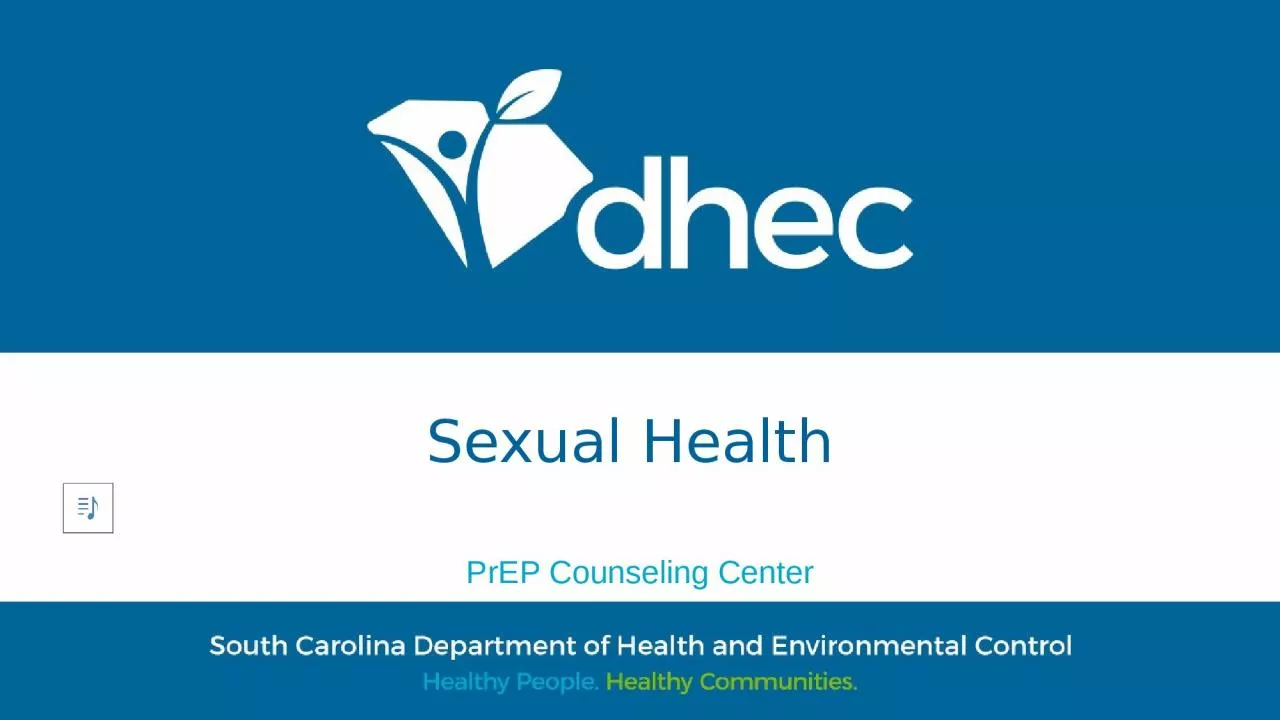

What is Sexual Health The CDC defines sexual health as a state of physical emotional mental and social wellbeing in relation to sexuality Sexual health requires a positive and respectful approach to sexuality and sexual relationships as well as the possibility of having ID: 1047659
Download Presentation The PPT/PDF document "Sexual Health PrEP Counseling Center" is the property of its rightful owner. Permission is granted to download and print the materials on this web site for personal, non-commercial use only, and to display it on your personal computer provided you do not modify the materials and that you retain all copyright notices contained in the materials. By downloading content from our website, you accept the terms of this agreement.
1. Sexual Health PrEP Counseling Center
2. What is Sexual Health?The CDC defines sexual health as: a state of physical emotional, mental and social well-being in relation to sexuality.Sexual health requires a positive and respectful approach to sexuality and sexual relationships, as well as the possibility of having pleasurable and safe sexual experiences that are free of coercion, discrimination and violence.
3. Sexual Health is UniversalSex is a natural human act.Everyone engaging in sexual activity or planning to engage in sexual activity should have a sexual health plan.A sexual health plan is a physical and mental journey one has for engaging in healthy sexual relationships, preventing STIs and HIV, and planning pregnancies.
4. Reproductive HealthReproductive health includes sexual health.This refers to the ability to have children.World Health Organizations (WHO) defines reproductive health as: "...state of complete physical, mental and social well-being and not merely the absence of disease or infirmity, in all matters relating to the reproductive system and to its functions and processes."
5. Family PlanningPregnancy PreventionBirth control (implant, pills, rings, etc.)CondomsAbstinenceSterilization (tubal ligation or vasectomy) Planned/Unplanned PregnancyConsult your physician (medications and vaccinations)Make a plan (mental and physical stability)Adjust lifestyle and behaviors (avoid toxic substances such as drugs and alcohol)
6. LGBTQ+ HealthLGBTQ+ people are normal and exist within every community, but are at increased risk for several health threats when compared to their heterosexual peers.LGBTQ+ people have the right to sexual health and sexual pleasure without the risk of disease, violence, and discrimination.Education about other forms of sexual activities is important to reduce these risks.
7. Sexual Violence PreventionSexual violence is sexual activity without consent or freely given.Sexual violence is common. Over half of women and almost 1 in 3 men will experience sexual violence in their lifetime.Sexual violence starts early. 1 in 3 female victims experience rape by age 11-17, and 1 in 8 experienced rape before the age of 10. 1in 4 male victims experience rape by age 11-17 and 1 in 4 experienced rape before the age 10.https://www.cdc.gov/violenceprevention/sexualviolence/fastfact.html
8. Sexually Transmitted Infections (STIs)STIs are spread during unprotected sexual contact with someone who already has the infection. STIs can be transmitted through oral, vaginal or anal sex.STIs are common and affect almost EVERYONE!Common STIs: chlamydia, gonorrhea, trichomoniasis, syphilis, genital warts (HPV), HIV, and genital herpes.
9. Sexually Transmitted DiseasesSTIs greatly affect adolescents and people aged 15-24, so it’s important to begin practicing safer sexual health habits whenever you begin engaging in sexual activity.Chlamydia, gonorrhea and syphilis cases have been rapidly rising with 2.5 million new cases in 2021.Chlamydia, gonorrhea and syphilis increases one’s chance of getting HIV.
10. Take control of your SEXUAL HEALTH!Talk about sex honestly with partner(s).Engage in safe and pleasurable sex.Take responsibility for your sexual safety.Protect yourself and partner(s) from STIs.Use condoms. Talk to your doctor about DoxyPEPGet tested. The CDC recommends everyone get tested for HIV at least once a year. Those who are sexually active and/or have multiple partners should be tested for HIV and STIs every 3-6 months.Get vaccinated (This includes HPV, HBV and mpox).
11. TAKE CONTROLWRITE YOUR OWN STORYProtect yourselfCondoms (have your own supply!) PrEP, nPEP and doxyPEPAbstinenceRoutine STI and HIV testingFamily planningPersonal Risk Reduction Plan
12. Tips to Improve Sex Life
13. ReferencesCenters for Disease Control and Prevention (2022). Fast facts: Preventing sexual violence. https://www.cdc.gov/violenceprevention/sexualviolence/fastfact.html Centers for Disease Control and Prevention [CDC], 2024, Sexual health, https://www.cdc.gov/sexualhealth/Default.html.Mayo Clinic Staff, 2023, Sexual Health, https://www.mayoclinic.org/healthy-lifestyle/sexual-health/basics/sexual-health-basics/hlv-20049432.
14. Andre Jennings, DHA, HIV-PCPPrEP Program Coordinator IIDHEC Central OfficeOffice: 803-898-8088Cell: 803-973-1349Email: jenninaj@dhec.sc.gov